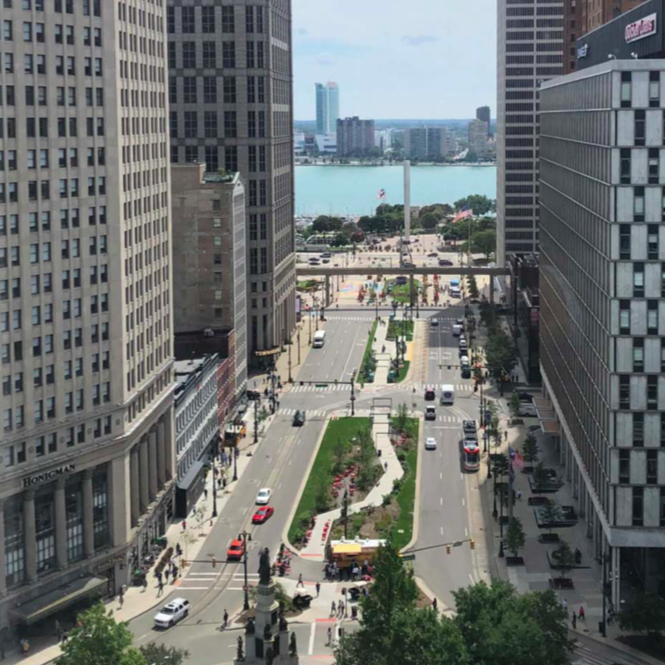How Car Insurance Impacts Cost of Living Across the U.S. – Streetsblog USA

Editor’s Note: A version of this article originally appeared on City Observatory and is republished with permission.
Everyone loves to compare the affordability of different cities, and most of the attention gets focused on differences in housing prices and rents. Clearly, these are a major component of living costs, and they vary substantially across the nation. But as we’ve regularly pointed out at City Observatory, transportation costs also vary widely across cities, and some places that have somewhat more costly housing also have more compact development patterns and less sprawl, and therefore enable their residents to spend less on cars and gasoline for transportation. These differences can create a significant impact on the overall cost of living across cities. We’ve computed the difference in city living costs in our Sprawl Tax report.
There’s another important component to differing living costs across the nation that we think deserves additional attention: insurance costs. Nearly all drivers and the majority of homeowners carry insurance on their cars and homes. Insurance premiums vary widely across the US, based on differences in crash rates, losses to natural disasters, and state-to-state variations in legal standards (as well as other factors).
Car insurance is a requirement for many people living in auto-dependent places. Wide sprawling metropolitan areas often require more miles to be driven for commuting. We are curious about the role that insurance plays in relation to the cost of living. When a car is required to commute to work or the store, insurance is a necessity to protect yourself and the car. The price of insurance is dependent upon one’s personal background as well as the makeup of one’s setting. Location plays a major role, whether it be state policy, natural regional differences, or the composition of the insurance pool around you. Insurance can become a vital and costly expense for Americans. The magnitude of that expense could severely influence the way we view the overall cost of living across major cities.
Which cities have the least (and most) expensive auto insurance rates?
Using data from TheZebra.com, we compiled the average annual auto insurance premiums across the 53 largest metropolitan areas in the United States. The Zebra estimated the typical premium paid by a 30 year old single male driving a Honda Accord. In the typical large US metropolitan area, the average automobile insurance premium is about $1,800 per year. The rankings of large metros are shown below. Premiums in these large metros are higher than the overall national average auto insurance premium. In general, rural areas have generally lower rates. Insurance companies base their rates upon the perceived risk at obtaining a claim. The more at-risk the company is at receiving a claim, the higher their insurance rates will be. Cities increase the risk, as insurance companies report that claims are higher in urban areas, thus their rates increase accordingly.
The cities with the highest car insurance rates were Detroit, New Orleans, Miami, and New York. Detroit, by far the highest, had an average insurance rate of $6,280. The Motor City has annual prices approximately four times higher than the median rate for large metropolitan areas. The cities with the lowest car insurance premiums were Cincinnati, Charlotte, Virginia Beach, and Raleigh. These annual rates were all between $900 and $1200, significantly lower than the highest tier. Generally inexpensive cities (25th percentile) and generally expensive cities (75th percentile) vary by $670.
Other living cost estimates, like the sprawl tax, vary differently than auto insurance rates. The sprawl tax in particular has less extreme values, yet a wider range of variation across the middle of the data. The median sprawl tax, $1,302, is less than the median insurance rate by roughly $500. At the same time, the sprawl tax in generally inexpensive cities compared to generally expensive cities is nearly $1000, a greater difference than insurance rates. Insurance premiums in the most expensive cities are by far greater than the sprawl tax. These clear outliers make the distribution of auto insurance premiums standout compared to other living cost estimates.
Another interesting difference can be seen by examining which cities standout across sprawl tax and car insurance. For instance, New Orleans and New York are two of the most expensive cities to insure your car. Yet, they have the lowest sprawl tax. Moreover, five of the ten most expensive cities to insure your car are all below the 25th percentile for the sprawl tax. Let’s take a closer look at the relationship between miles traveled and insurance rates. Using data from the Center for Neighborhood Technology, we compiled the annual vehicle miles traveled per household across metropolitan areas and compared it to the auto premiums. We assumed that we would see a positive relationship. The more miles you drive, the greater your risk for filing a claim. Instead, we found the opposite – auto insurance rates decreased as annual VMT per household increased.
Insurance rates were lower in the places where people drove more often. Insurance rates were higher in places where people had lower sprawl taxes. Why? Car dependence. In sprawling metropolitan areas, people need to drive themselves to get where they need to go. People are reliant on their cars for nearly all commuting travel, which in turn makes insurance a necessity. Insurance pools grow with more insurers distributing the risk of payout across more people, which consequently decreases rates. Sprawl may have a negative impact on insurance rates because of its impact on the demand for insurance.
We believe that the structure of insurance policy is a strong contributor in the variation of rates across metro areas. State laws regulate the market for automotive insurance policies, which can be choice no-fault, a tort liability, or a combination of both. A no-fault state means that in the event of an accident, neither driver is deemed “at fault” and both drivers use their insurance to cover their own damages. As a result of this, no-fault states require personal injury protection (PIP) to cover medical costs, economic benefits, and death benefits. This additional protection on top of the ordinary liability can raise prices. Michigan is a no-fault state that also requires personal property insurance (PPI), and Detroit feels the consequences of that. In fact, 6 out of the top 10 cities for annual auto insurance rates (Detroit, Miami, New York, Tampa, Grand Rapids, and Philadelphia) are all in no-fault states. PIP requirements are likely a key player for the higher prices. Starting in July 2020, the state of Michigan readjusted their auto insurance policy to allow the insured to choose their level of PIP. This may lead to reductions in overall costs in the nation’s most expensive city for car insurance.
A city’s demographics are also important to consider when thinking about insurance rates. We have explored discrimination in automobile insurance before at City Observatory. We found that there were higher auto insurance rates in black neighborhoods, even those with safe drivers. Black drivers were found to be less likely to speed, yet they pay substantially more because of living in a predominantly Black neighborhood. A quick look at our data shows that several of the cities with the largest Black populations—Detroit, New Orleans, Philadelphia, and Baltimore—face some of the highest premiums of all the 53 largest metros. Race and population demographics could help explain some of this variation in average insurance premiums across the country.
Auto Insurance and the Cost of Living
As we explained in our Sprawl Tax series, the Bureau of Economic Analysis Regional Price Parities (RPP) is the most comprehensive measure we have of inter-metropolitan differences in consumer prices. Variations in rents are the largest component of overall cost-of-living variations between cities. But, how does the variation in auto insurance premiums relate to the variation in housing costs? Does the cost of insuring your car significantly change the cost of living? We compared the BEA’s RPP for Rent with the insurance data below. BEA’s RPP for rent does not include the cost of insurance. Insurance is included within the RPP for services, however it does not hold significant weight on their calculations (only about 6%).
Comparing insurance rates to BEA RPP’s for rent, we find a slightly positive relationship with auto insurance and cost of living. This trend points us to consider that there might be an increasing effect for auto insurance rates and housing costs. However, when thinking about insurance and the cost of living, it is imperative to consider the quantity of insurance. Whether or not someone insures their car is dependent upon the makeup of the city.
For example, in New York City, auto insurance is quite expensive, but owning a car is not a necessity for living within the city. The accessibility of consistent public transportation and the walkability of the city remove the need for a car and thus auto insurance. An interesting trend we have noticed in our data is that as annual vehicle miles traveled per household increases, the insurance rate decreases. So, while insurance rates might be high in cities like New York, a car is not a vital aspect of living within the city. New York’s relatively high car insurance rates aren’t a cost burden for the large number of households that don’t own cars. This is similar to our takeaways comparing insurance to the sprawl tax. High insurance rates may be more due in part to a lesser demand to drive a car and thus a lesser demand to insure an automobile. Car dependence makes auto insurance a necessary additional cost of living. However, limited sprawl and accessible alternative modes of transportation create an environment where insurance is not required. While this may cause rates to increase, it does not imply an increase in the overall cost of living.
The real impact on the cost of living arises when automobile insurance is a required aspect of living. Looking objectively at the rankings does not paint the picture of cost of living. We must consider the auto dependence and the sprawl tax across these metropolitan areas to attribute the cost of insurance into transportation costs. It seems simple: people who don’t drive don’t insure cars. For those who must drive, auto insurance can pose an expensive burden annually. For those who don’t, the omission of auto insurance from their expenses is a valuable amenity. It is important to consider not only how much insurance costs but where the costs are necessary.
All in all, the cost of insuring a car can create a serious dent in your paycheck depending upon where you live. If you move across Pennsylvania from Pittsburgh to Philadelphia, your rates could increase by over $1000. The variation between these cities is notable. Racism and the structure of insurance policy may be major contributors, but other factors, like density and land use policy, might help explain this variation as well. Car dependence results in car insurance dependence. When you have to drive, insurance can place a burden onto your budget. This is where the impact on cost of living appears. People can save a whole lot of money annually when they do not need to insure an automobile.
Eli Molloy is a writer for City Observatory.
This content was originally published here.




Responses